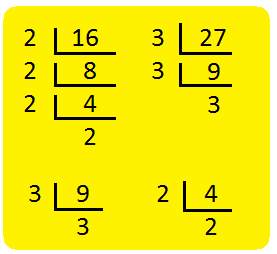Subscribe to our ▶️ YouTube channel 🔴 for the latest videos, updates, and tips.
Dividing Fractions
We will discuss here about dividing fractions by a whole number, by a fractional number or by another mixed fractional number.
First let us recall how to find reciprocal of a fraction, we interchange the numerator and the denominator.
Find the reciprocal of 3 ¾
I. Division of a Fraction by a Whole Number:
4 ÷ 2 = 2 means, there are two 2’s in 4.
6 ÷ 2 = 3 means, there are two 2’s in 6.
Similarly 5 ÷ \(\frac{1}{2}\) means, how many halves are there in 5?
We know that \(\frac{1}{2}\) + \(\frac{1}{2}\) = 1
|
\(\frac{1}{2}\) + \(\frac{1}{2}\) + |
\(\frac{1}{2}\) + \(\frac{1}{2}\) + |
\(\frac{1}{2}\) + \(\frac{1}{2}\) + |
\(\frac{1}{2}\) + \(\frac{1}{2}\) + |
\(\frac{1}{2}\) + \(\frac{1}{2}\) | |
|
1 + |
1 + |
1 + |
1 + |
1 |
= 5 |
i.e. there are 10 halves in 5.
5 ÷ \(\frac{1}{2}\) = 5 × \(\frac{2}{1}\) = \(\frac{10}{1}\) = 10
For Example:
1. \(\frac{7}{10}\) ÷ 5 = \(\frac{7}{10}\) ÷ \(\frac{5}{1}\)
= \(\frac{7}{10}\) × \(\frac{1}{5}\)
= \(\frac{7 × 1}{10 × 5}\)
= \(\frac{7}{50}\)
|
2. What is \(\frac{10}{15}\) ÷ 5? \(\frac{10}{15}\) ÷ \(\frac{5}{1}\) = \(\frac{10}{15}\) × \(\frac{1}{5}\) = \(\frac{2 × \not 5 × 1}{3 × \not 5 × 5}\) = \(\frac{2}{15}\) |
10 = 2 × 5 15 = 3 × 5 5 = 1 × 5 |
To divide a fraction by a number, multiply the fraction with the reciprocal of the number.
For example:
3. Divide 3/5 by 12
|
Solution: 3/5 ÷ 12 = 3/5 ÷ 12/1 = 3/5 × 1/12 = (3 × 1)/(5 × 12) = 3/60
= 1/20 |
Step I: Find the reciprocal of the whole number and multiply with the fractional number as usual.
Step II: Express the product in its lowest terms. |
4. Solve: 5/7 ÷ 10
|
= 5/7 ÷ 10/1
= 5/7 × 1/10 = (5 × 1)/(7 × 10) = 5/70 |
Step I: Find the reciprocal of the whole number and multiply with the fractional number as usual. Step II: Express the product in its lowest terms. |
II. Division of a Fractional Number by a Fractional Number:
For example:
1. Divide 7/8 by 1/5
|
Solution: 7/8 ÷ 1/5 = 7/8 × 5/1
= (7 × 5)/(8 × 1) = 35/8 = 4 3/8 |
Step I: Find reciprocal of 1/5. Step II: Multiply 7/8 by it. Step III: Express the product in its simplest form. |
2. Divide: 5/9 ÷ 10/18
|
Solution: 5/9 ÷ 10/18 = 5/9 × 18/10
= (5 × 18)/(9 × 10) = 90/90 = 1 |
Step I: Find reciprocal of 1/5.
Step II: Multiply 7/8 by it. Step III: Express the product in its simplest form. |
Division of a Fraction by a Fraction:
3. Divide \(\frac{3}{4}\) ÷ \(\frac{5}{3}\)
Step I: Multiply the first fraction with the reciprocal of the second fraction.
Reciprocal of \(\frac{5}{3}\) = \(\frac{3}{5}\)
Therefore, \(\frac{3}{4}\) ÷ \(\frac{5}{3}\) = \(\frac{3}{4}\) × \(\frac{3}{5}\)
= \(\frac{3 × 3}{4 × 5}\)
= \(\frac{9}{20}\)
Step II: Reduce the fraction to the lowest terms. (if necessary)
|
4. Divide \(\frac{16}{27}\) ÷ \(\frac{4}{9}\) Therefore, \(\frac{16}{27}\) ÷ \(\frac{4}{9}\) = \(\frac{16}{27}\) × \(\frac{9}{4}\); [Reciprocal of \(\frac{4}{9}\) = \(\frac{9}{4}\)] = \(\frac{\not 2 × \not 2 × 2 × 2 × \not 3 × \not 3}{\not 3 × \not 3 × 3 × \not 2 × \not 2}\) = \(\frac{4}{3}\) = 1\(\frac{1}{3}\) |
16 = 2 × 2 × 2 × 2 9 = 3 × 3 27 = 3 × 3 × 3 4 = 2 × 2 |
III. Division of a Mixed Number by another Mixed Number:
For example:
1. Divide 2 ¾ by 1 2/3
|
Solution: 2 ¾ ÷ 1 2/3 = 11/4 ÷ 5/3
= 11/4 × 3/5 = (11 × 3)/(4 × 5) = 33/20 = 1 13/20 |
Express the mixed numbers as improper fractions and multiply as usual. |
2. Divide: 2 4/17 ÷ 1 4/17
|
Solution: 2 4/17 ÷ 1 4/17 = 38/17 ÷ 21/17 = 38/17 × 17/21
= (38 × 17)/(17 × 21) = 646/357 = 38/21 = 1 17/21 |
Express the mixed numbers as improper fractions and multiply as usual. |
Questions and Answers on Dividing Fractions:
I. Divide the following.
(i) \(\frac{2}{6}\) ÷ \(\frac{1}{3}\)
(ii) \(\frac{5}{8}\) ÷ \(\frac{15}{16}\)
(iii) \(\frac{5}{6}\) ÷ 15
(iv) \(\frac{7}{8}\) ÷ 14
(v) \(\frac{2}{3}\) ÷ 6
(vi) 28 ÷ \(\frac{7}{4}\)
(vii) 2\(\frac{5}{6}\) ÷ 34
(viii) 9\(\frac{1}{2}\) ÷ \(\frac{38}{2}\)
(ix) 3\(\frac{1}{4}\) ÷ \(\frac{26}{28}\)
(x) 7\(\frac{1}{3}\) ÷ 1\(\frac{5}{6}\)
(xi) 2\(\frac{3}{5}\) ÷ 1\(\frac{11}{15}\)
(xii) 1\(\frac{1}{2}\) ÷ \(\frac{4}{7}\)
Related Concept
● Representation of a Fraction
● Properties of Equivalent Fractions
● Comparison of Like Fractions
● Comparison of Fractions having the same Numerator
● Conversion of Fractions into Fractions having Same Denominator
● Conversion of a Fraction into its Smallest and Simplest Form
● Addition of Fractions having the Same Denominator
● Subtraction of Fractions having the Same Denominator
● Addition and Subtraction of Fractions on the Fraction Number Line
From Dividing Fractions to HOME PAGE
Didn't find what you were looking for? Or want to know more information about Math Only Math. Use this Google Search to find what you need.




New! Comments
Have your say about what you just read! Leave me a comment in the box below. Ask a Question or Answer a Question.